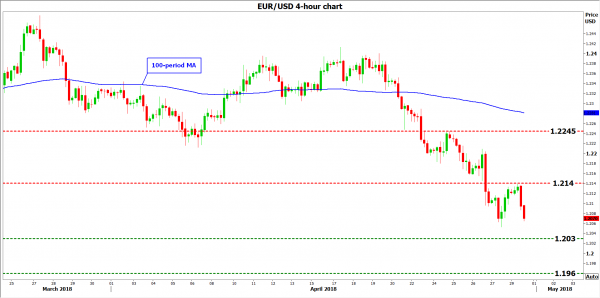The Eurozone will see the release of its preliminary GDP for Q1 as well as its unemployment rate for March, both on Wednesday at 0900 GMT. Forecasts point to a slowdown in economic growth, something that would likely vindicate the European Central Bank’s (ECB) recent shift to a more cautious stance.
It’s no secret that economic growth in the Eurozone probably slowed in the first quarter of the year. Business surveys such as the Purchasing Managers Indices (PMIs) have been pointing to a slowdown for months now, and even ECB President Draghi acknowledged as much at last week’s policy meeting, when he noted economic data have moderated recently. Still, investors will probably keep a close eye on the release of the official GDP figures, in order to gauge whether the slowdown was more or less pronounced than originally thought, and to what extent that will impact the ECB’s thinking.
In terms of forecasts, the bloc’s preliminary GDP estimate for Q1 is projected to show that the economy grew by 0.4% on a quarterly basis, a much slower pace than the 0.6% recorded in Q4. In yearly terms, growth is anticipated to have slowed to 2.5%, from 2.7% in Q4. Meanwhile, the unemployment rate is expected to have held steady at 8.5%, after ticking down in February.
While the ECB still looks set to begin scaling back its massive stimulus program later this year, with some signaling of that likely to come in the summer meetings, economic data will be critical to watch as continued deterioration could make the Bank more cautious to head towards the exit door.
Thus, in case these data disappoint – for instance if growth slows by more than expected – that could reinforce speculation that the Bank may choose to delay its normalization plans until the economy rebounds, potentially bringing the euro under renewed selling pressure. Looking at euro/dollar, in case of further declines support may be found near the 1.2030 hurdle, marked by the peak of September 20. A downside break of that zone could open the way for the 1.1960 area, defined by the top of November 27.
On the flip side, should these figures – and particularly the GDP print – come in better than expected, that could dispel some concerns that the ECB will be hesitant to normalize its policy and thereby, help the euro to recover some of its latest losses. Advances in euro/dollar could initially stall near 1.2140, the April 30 high. If buyers overcome that barrier, the next territory to offer resistance may be near 1.2245, a hurdle that capped the rally on April 24.
Finally, besides the GDP and unemployment prints, the other key data release from Eurozone this week will be the preliminary inflation data for April, which are due out on Thursday.














